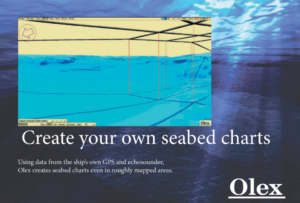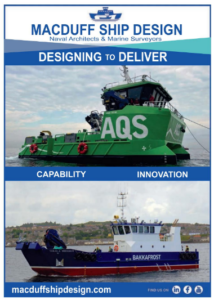Innovation at sea
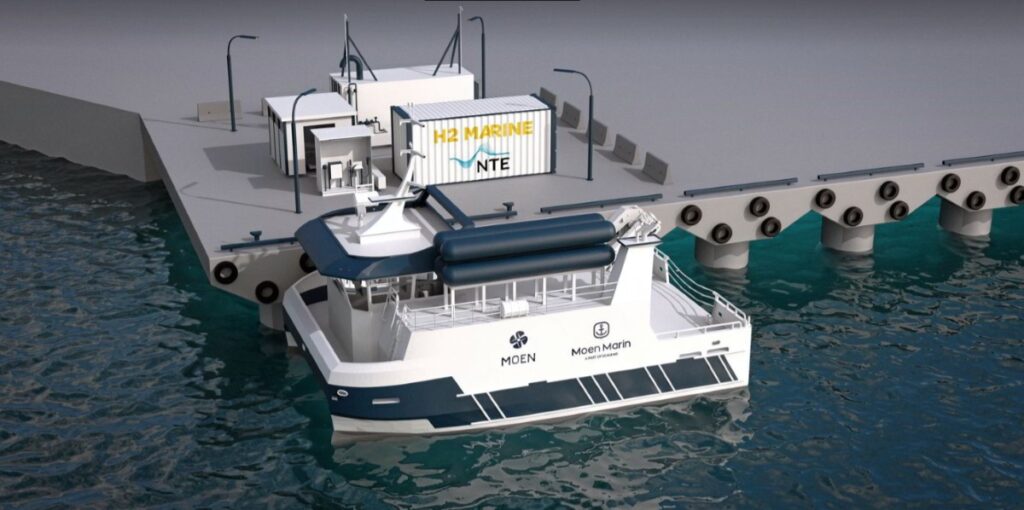
The marine sector is changing, with alternative fuels and bigger vessels coming onto the market, says Sandy Neil
The world’s first hydrogen workboat, the UK’s first 100% electric workboat, the return of shipbuilding to Stornoway, a new super-sized wellboat and a merger between marine operators have all helped to make it an eventful 2023 and 2024 so far. This month, we round up the latest news and trends in marine vessels, from workboats to wellboats.
“The world’s first hydrogen-powered workboat” may be ready for a Norwegian fish farmer as early as Q2 2024.
It has been developed by Moen Marin, the largest supplier of aquaculture work vessels, in collaboration with Moen Verft, Marin Design and the Norwegian government technical support organisation Enova. It will be operated by SalMar, the world’s second-largest salmon company, and comes with a price tag of NOK 24.8 million (£1.85m).
Moen Marin explained: “The boat is a catamaran and will be a hydrogen-electric hybrid, with a 276kWh battery in addition to the four hydrogen tanks from Hexagon, totalling 120kg of hydrogen.
A fuel cell from ZEM with a capacity of 145kW will also be installed. This vessel will be a zero-emission boat and will reduce CO2 emissions by average 300 tonnes per year.
“Regulating hydrogen boats requires careful review of safety standards and operating protocols. The placement of hydrogen tanks and adaptation to maritime use are among the many challenges that must be addressed. Despite these obstacles, Moen Marin is determined to adapt the boat to SalMar’s needs and challenge current regulations to open up a new market for hydrogen vessels.”
A pilot production facility has also been established at Kråkøya in Nærøysund, where water and wind power will be used to produce hydrogen. The facility, established by NTE and H2Marine, will serve as a “charging station” for the hydrogen vessel – in addition to being a facility for the production, storage and bunkering of green hydrogen.
Moen Marin said: “This ground-breaking project is a major milestone for the aquaculture industry and moves us in the right direction at a time when innovative, sustainable solutions like this will be essential. With only five hydrogen hubs nationally, of which the facility at Kråkøya will be the only one designed for maritime use, we are thus participating in the start of an entirely new market.”
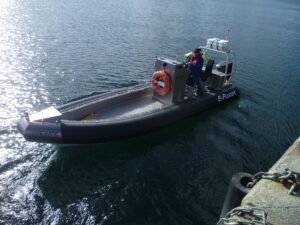
Flugga boats
Flugga goes electric
Meanwhile in Shetland, Unst Inshore Services Ltd has built the UK’s first 100% electric workboat, the “E-Flugga”, which is waiting to be delivered to a salmon farmer in the islands.
The 7.5m Fluggaboat uses an Evoy 120hp continuous rated, electric outboard powered by a 63kWh lithium-Ion battery housed in the console.
Charging is by an onboard charger so it can be fully charged overnight or topped up during the day depending on the rate of use.
The top speed is 30 knots, but the most economical speed is 24 knots – the slower speed will provide a slightly longer range. The touch-screen dash panel displays the battery state of charge and use, constantly updated speed and range, motor RPM and kilowatt. Below 20%, the battery management system will go into a “get home” reduced power mode to enhance the range for the return trip to a charge point.
A spokesperson told us: “We exhibited the boat at Aquaculture UK and the amount of interest was impressive.
“The propulsion system is by Norwegian firm Evoy and is 120hp continuous rated. It has built-in charging for the liquid cooled 63kWh lithium-Ion battery. The unit is monitored over the internet for diagnosis and software updates via the touch-screen.
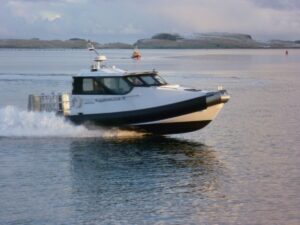
Flugga boats
“We find the boat has a best speed/range at around 24 knots, which was a nice surprise. To find we had achieved pretty much exactly what we planned was satisfying.
“The most difficult part of the whole process was the coding. We like to code the boats before delivery; this way they are ready to operate on delivery and the boat is an approved unit. Being the first was the main problem, as some of the regulation was new and finding the correct way forward was troublesome.
“With a lot of help from Mecal and guidance from the MCA, the boat is now ready for delivery.
“The boat is going to a salmon farm in Shetland, which will allow us to monitor it and find ways to improve the build. It will be interesting to see what improvements we can find and the guys are keen to get to grips with it.”
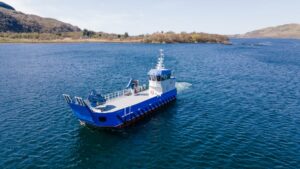
Coastal Workboats’ Tiffany II
Investing in Lewis
And on the Isle of Lewis, Coastal Workboats is growing its local team. Following the signing of a 10-year lease of Stornoway Port Authority’s Marine Engineering Workshop at the end of last year, Coastal Workboats’ 2024 is fast becoming “a period of sustained development” as the Devon-based company grow their UK-wide capacity.
Coastal Workboats is busy settling into Stornoway, now its primary fabrication centre, with a fit-out of the new premises already seeing a local spend of over £200k and a recruitment campaign for 25 new jobs.
Key appointments of locals Catherine Thompson as Business Manager and Billy Ferguson as Welding Supervisor are a critical part of the company’s “local-first” approach, explains its Director Brian Pogson: “We understand that longevity starts at home and are acutely aware we’re nothing without our people. As a result, we’re thoroughly enjoying the unfolding community as we work with Catherine and Billy to build our Stornoway team from the industry-leading talent that the island has nurtured and attracted.
“It’s a privilege to contribute to the many ways Stornoway is leading the UK’s reputation for maritime innovation and safeguarding our industry’s international future.”
Alex MacLeod, Chief Executive at Stornoway Port Authority, said: “The facility at Goat Island is world-class, with overhead cranes specifically designed for vessel construction.
“This agreement marks the return of a dedicated shipbuilder in Stornoway for the first time in 100 years. We are proud to have played our part in bringing this industry back to the island.”
Coastal Workboats’ presence in Stornoway builds on a reputation for innovation – the first vessel laid down at the new site will be an all-electric offering to the ferry and workboat industries, dubbed the E-LUV. The demonstrator vessel is due to go on trial in Shetland next year on the West Burrafirth to Papa Stour route, the project getting underway with the setting of the vessel jig in the coming weeks after steels arrived on site in February.
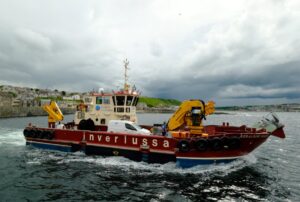
Geraldine Mary, Macduff Ship Design and Inverlussa
Workboat under construction at Macduff
In the northeast, following completion of the Turas A Bhradain for Bakkafrost Scotland last year, a sister vessel is under construction at Macduff Shipyards. The 24m landing craft workboat has minor upgrades and is scheduled for delivery later this year.
“We have recently signed a contract with Macduff Shipyards to develop a new design 18.5m aquaculture service catamaran,” said Macduff Ship Design Ltd’s Managing Director, Ian Ellis. “The design is in initial development stages.”
The Aberdeenshire company is working with Skagen Ship Consulting on a number of other projects, including two 18.5m landing crafts. “The hulls are based on a shorter version of the successful 21m landing crafts Helen Rice and Geraldine Mary in service, with aft poop deck and wheelhouse,” Ellis said.
Add to these a 14.95m ensilage vessel and an 18.5m battery electric catamaran service vessel nearing completion and delivery.
“It is technologically challenging with a battery electric drive train supported by two diesel generators,” he added. “The deck package is state of the art with multiple cranes and cage/anchor handling equipment.
“We also have been working with Inverlussa Marine and Nauplius workboats on the delivery of a third vessel in the 21m landing craft series. Further to this, we are working with a number of owners and shipyards looking at future trends and vessel requirements, with the hope that we will see agreement on these new projects.
“The projects include development of a vessel site boat capable of completing as many day-to-day tasks as possible. We have also spent time working on alternative fuels and technologies to understand the most suitable options available within the sector.”
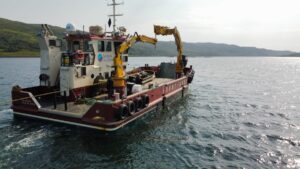
Inverlussa’s Arthur Douglas, built at Nauplius Shipyard
Busy time for Inverlussa
In other news, Inverlussa Marine Services had a busy 2023, with a number of vessels of varying shapes and sizes brought into service.
Sister ships Eloise Eslea and Isaac Eslea, both built by Nauplius Workboats in the Netherlands, entered service as state-of-the-art de-licing vessels, the Mull-based company explained.
“Hybrid power systems on both vessels have resulted in lower fuel consumption and the ability to run purely on batteries overnight and when on standby. Both vessels are also equipped with dynamic positioning to increase usability in adverse weather and provide a safer working environment for the crew. Eloise and Isaac Eslea are now both in service with Scottish Sea Farms and Cooke Aquaculture Scotland respectively, and are market-leading, high-capacity delousing vessels.”
In September, the company took delivery of another hybrid vessel, this time built by Salthammer in Norway.
“Charlie Knight is a market-leading, DP, heavy site service vessel designed principally for working with the mooring equipment associated with salmon farms,” it said.
“As well as modern power and control systems, the Charlie Knight is equipped with some of the most advanced deck equipment, including 25T deck winch, hydraulic-powered mooring plate lock and the most powerful deck cranes in Inverlussa’s fleet.”
Inverlussa also took delivery of John Wilson, a 15m NabCat, which was built in 2019 for Norwegian company FDA. John Wilson comes complete with SHM deck equipment, which will increase crew safety when working with large, heavy mooring components.
John Wilson is the third NabCat in Inverlussa’s fleet and “they have proved to be reliable and adaptable boats, well-suited for the varied work that comes with fish farming”, Inverlussa said.
Projects in 2024 include delivery of another site service vessel based on the successful Macduff-designed Helen Rice. Arthur Douglas is under construction by Nauplius and delivery is expected in Q2 of this year. This will be the third vessel of this type built by Inverlussa to specific standards, with efficient use of deck space and heavy duty deck equipment getting particular attention.”
Commenting on an “ambitious and successful 2023” and looking forward to 2024, Managing Director Ben Wilson said: “The hybrid technologies we have brought into the market increase vessel utilisation and productivity, which in turn helps to drive down the costs for customers. We want to be market leader in providing site services to producers in Scotland and to do this we must stay at the forefront of technology and innovation and reinvest in our fleet and crew.”
Wellboats go large
Sølvtrans, a major global supplier of wellboat services, has taken delivery of a new super-sized vessel. The 77m-long Ronja Evolution has been handed over by Norwegian builders Aas Mech and is the seventh vessel it has on order for Sølvtrans. This latest vessel has a capacity of 3,000m3, which means it can carry around 450 tonnes of live fish.
Sølvtrans now has a fleet of around 35 vessels in service in Norway and in countries around the world including Scotland. The Ronja Evolution has a system which allows for zero emissions during closed transport and a filter system which allows for the separation of lice when de-licing operations are taking place.
All wastewater from the lice filter is run through separate filters for separation of dry matter/lice and further UV treatment of the purified wastewater. Lice are collected in containers that are destroyed on board or delivered ashore for disposal.
Sølvtrans was established in 1986 with a rebuilt freighter that had a cargo capacity of 208m3. The term Ronja, which is the prefix on all its vessels, is named after the founder’s two children Robin and Anja.
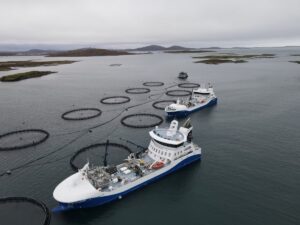
Intership Inter Scotia and Inter Atlantic
Getting together
As reported in our January issue, two leading Norwegian-based wellboat businesses – AquaShip and Intership – are merging following a deal that saw both taken over by a US investment fund.
AquaShip claims to be the only company that owns and operates vessels in all four main areas of aqua services. It operates a fleet of 28 vessels, consisting of live-fish carriers, utility vessels, harvest vessels, fish feed carriers and service vessels, with operations in Norway, Scotland, Ireland, Chile, Canada and Shetland.
Intership has built one of the world’s most modern wellboat fleets and has proven to be an innovative player by bringing new and fish-friendly freshwater treatment for lice and gill diseases into the market. Together, the combined company will have a fleet of 39 vessels and nearly 700 employees operating in Chile, the UK, Ireland, Canada, and Norway.
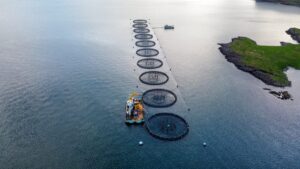
Aquaship service
vessel at farm
A spokesperson for the combined company, yet to reveal its new name, told us: “In Scotland and Ireland, our combined operations now boast a fleet of 15 vessels, including a variety of vessel types. With the upcoming introduction of a new build, set to be the largest and most advanced aquaculture vessel in the UK, and with one more vessel set to enter operation this spring, our total fleet will expand to 17 vessels.
“This expansion will increase our UK wellboat capacity to almost 20,000m3, catering to the growing demand for diversified aqua services. Among this fleet, our most specialised vessels are capable of producing a total of up to 25,000m3 of freshwater per 24 hours.
“This freshwater is generated through reverse osmosis systems, providing a cost-effective, highly efficient and environmentally friendly method for dealing with sea lice, amoebic gill disease and other gill infection challenges faced by salmon farmers.”
Sverre Taknes, CEO of AquaShip and CEO of the combined company, said: “Together, we aim to unlock new, impactful partnerships across all regions and further enhance our already excellent service to customers.”

